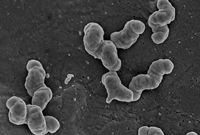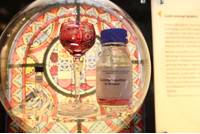Hydrogen powers important nitrogen-transforming bacteria
Nitrogen, an essential chemical element for life, is transformed into its different chemical
forms in numerous steps of the global nitrogen cycle. Nitrite-oxidizing bacteria are important
players in nitrogen cycling since they convert the toxic nitrite to the less harmful nitrate.
"Humans exploit this process in biological wastewater treatment. Moreover, the formed nitrate is a
substrate for other important microbial processes and a source of nitrogen for many plants"
explains Hanna Koch, first author of the study and Ph.D. student at the Department of Microbiology
and Ecosystem Science of the University of Vienna. Since the description of the first
nitrite-oxidizing bacteria in the 19
th century, scientists have assumed that the survival of these microorganisms would
depend on nitrite as their source of energy. Therefore, the presence of nitrite-oxidizing bacteria
in the environment and in wastewater treatment plants has commonly been associated with the
nitrogen cycle.
 Autoren der Studie von der Universität Wien. Hinten (v.l.n.r.): Christiane Gruber-Dorninger,
Hanna Koch, Holger Daims. Vorn: Arno Schintlmeister, Michael Wagner (Foto: Allen Tsao, Universität
Wien).
Autoren der Studie von der Universität Wien. Hinten (v.l.n.r.): Christiane Gruber-Dorninger,
Hanna Koch, Holger Daims. Vorn: Arno Schintlmeister, Michael Wagner (Foto: Allen Tsao, Universität
Wien).
Nitrospira: Nitrite oxidizers with surprising features
The environmentally most widespread nitrite oxidizers belong to the genus Nitrospira. These
bacteria occur in the most different habitats such as soil, rivers, lakes and oceans, and even in
hot springs. In addition, Nitrospira are the key nitrite-oxidizing bacteria in wastewater treatment
plants. A team of scientists from Austria, Denmark, Germany, and France has now revealed surprising
facts about these microorganisms. "The genome analysis of a Nitrospira species indicated that this
bacterium might use hydrogen as an alternative source of energy" says Holger Daims from the
Department of Microbiology and Ecosystem Science of the University of Vienna. The potential of
Nitrospira to use hydrogen was then studied in detail.
NanoSIMS at the University of Vienna for high-resolution single-cell analyses
The hydrogen-dependent growth of Nitrospira could be visualized in individual bacterial cells
by using the high-resolution secondary ion mass spectrometer, also called "NanoSIMS", at the
University of Vienna. Under high vacuum conditions like in space, this method shoots small
particles out of single bacterial cells for subsequent identification by mass spectrometry. "This
exciting approach is feasible at very few research institutions worldwide", says Daims about this
high-tech equipment. The scientists could show that Nitrospira cells, which use hydrogen as the
source of energy, incorporate carbon dioxide into their biomass. This metabolic activity is linked
to cell proliferation and was important evidence that the Nitrospira bacteria indeed use hydrogen
for growth. These newly discovered features raise numerous questions about the lifestyle of the
"free-living" close relatives of this Nitrospira species in the environment and wastewater
treatment plants.
New insights into the ecology of nitrite oxidizers
"The oxidation of hydrogen not only enables Nitrospira to colonize unexpected habitats, but
also sustains their activity when nitrite is not available" explains Hanna Koch. Holger Daims adds:
"This discovery was a great surprise to us. In the next step, we will explore how extensively
environmental nitrite oxidizers use hydrogen as an energy source. Our goal is to better understand
the ecology of these important bacteria and their significance for the global cycles of nitrogen
and carbon". This study on nitrite-oxidizing bacteria was funded by the Vienna Science and
Technology Fund (WWTF) and the Austrian Science Fund (FWF).
Publication in Science
Growth of nitrite-oxidizing bacteria by aerobic hydrogen oxidation: Hanna Koch, Alexander
Galushko, Mads Albertsen, Arno Schintlmeister, Christiane Gruber-Dorninger, Sebastian Lücker, Eric
Pelletier, Denis Le Paslier, Eva Spieck, Andreas Richter, Per H. Nielsen, Michael Wagner, und
Holger Daims. In: Science,
DOI: 10.1126/science.1256985
www.univie.ac.at
 Nitrite-oxidizing bacteria are key players in the natural nitrogen cycle on Earth and in biological wastewater treatment plants. For decades, these specialist bacteria were thought to depend on nitrite as their source of energy. An international team of scientists led by Holger Daims, a microbiologist at the University of Vienna, has now shown that nitrite-oxidizing bacteria can use hydrogen as an alternative source of energy. The oxidation of hydrogen with oxygen enables their growth independent of nitrite and a lifestyle outside the nitrogen cycle. The study is published in the current issue of the journal "Science".
Nitrite-oxidizing bacteria are key players in the natural nitrogen cycle on Earth and in biological wastewater treatment plants. For decades, these specialist bacteria were thought to depend on nitrite as their source of energy. An international team of scientists led by Holger Daims, a microbiologist at the University of Vienna, has now shown that nitrite-oxidizing bacteria can use hydrogen as an alternative source of energy. The oxidation of hydrogen with oxygen enables their growth independent of nitrite and a lifestyle outside the nitrogen cycle. The study is published in the current issue of the journal "Science".


 Česky
Česky













